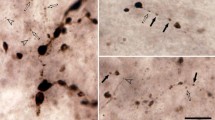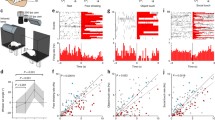Summary
The ability of ventral cord neurons to code the direction of a vibration source was tested.
The vibration receptors in all six legs were stimulated simultaneously or successively (i.e. with a time delay between stimulation of several leg pairs) in order to simulate vibration signals coming from ahead or behind the animal.
Three groups of vibration sensitive neurons were investigated by extracellular recordings:
-
1.
Bimodal vibro-acoustic ventral cord neurons ascending to the brain (VS-neurons). The response patterns of these neurons to vibrational stimulation does not significantly change, when the stimuli are presented simultaneously or successively. The effectiveness of the inputs from the several legs is remarkably different, however. Ipsilateral stimulation is more effective than a contralateral one; the influence of midand hindlegs is greater than that from the forelegs.
-
2.
Vibratory ventral cord neurons ascending to the brain (V-neurons). If the different leg pairs are stimulated successively with vibration signals, some of these V-neurons show significant changes in their responses which depend on the direction and the time delay of the presented stimuli.
-
3.
Vibratory interneurons restricted to the thoracic nerve cord. In these neurons (which connect the thoracic ganglia), the influence of the receptors of only one leg pair is dominant. Vibratory stimulation of other leg pairs does not alter the responses of these interneurons.
Similar content being viewed by others
Abbreviations
- fl :
-
forelegs
- ml :
-
midlegs
- hl :
-
hindlegs
References
Autrum H (1941) Über Gehör und Erschütterungssinn bei Locustiden. Z Vergl Physiol 28:580–637
Autrum H, Schneider W (1948) Vergleichende Untersuchungen über den Erschütterungssinn von Insekten. Z Vergl Physiol 31:77–88
Bacon JP, Altman JS (1977) A silver intensification method for cobalt-filled neurons in wholemount preparations. Brain Res 138:359–363
Bell PD (1980) Transmission of vibrations along plant stems; implications for insect communication. NY Entomol Soc 88:210–216
Brownell P, Farley RD (1979) Orientation to vibrations in sand by the nocturnal scorpionParuroctonus mesaensis: mechanism of target localization. J Comp Physiol 131:31–38
Čokl A, Kalmring K, Wittig H (1977) The responses of auditory ventral cord neurons ofLocusta migratoria to vibration stimuli. J Comp Physiol 120:161–172
Erulkar SD (1972) Comparative aspects of spatial localization of sound. Physiol Rev 52:237–360
Hergenröder R, Barth FG (1983) Vibratory signals and spider behaviour: how do the sensory inputs from the eight legs interact in orientation? J Comp Physiol 152:361–371
Kalmring K (1975) The afferent auditory pathway in the ventral cord ofLocusta migratoria (Acrididae). I. Synaptic connectivity and information processing among the auditory neurons of the ventral cord. J Comp Physiol 104:103–141
Kalmring K (1983) Convergence of auditory and vibratory senses at the neuronal level of the ventral cord in grasshoppers; its probable importance for behaviour in the habitat. In: Horn (ed) Multimodal convergences in sensory systems. Fortschr Zool 28:130–141
Kalmring K, Kühne R (1980) The coding of airborne sound and vibration signals in bimodal ventral-cord neurons of the grasshopperTettigonia cantans. J Comp Physiol 139:267–275
Keuper A, Kühne R (1983) The acoustic behaviour of the bushcricketTettigonia cantans. II. Transmission of airborne sound and vibration signals in the biotope. Behav Proc 8:125–145
Kühne R (1982a) Neurophysiology of the vibratory sense in locusts and bushcrickets: response characteristics of single receptor units. J Insect Physiol 28:155–163
Kühne R (1982b) Neurophysiology of the vibration sense in locusts and bushcrickets: the responses of ventral cord neurons. J Insect Physiol 28:615–623
Kühne R, Lewis B, Kalmring K (1980) The responses of ventral cord neurons ofDecticus verrucivorus to sound and vibration stimuli. Behav Proc 5:55–74
Latimer W, Schatral A (1983) The acoustic behaviour of the bushcricketTettigonia cantans: I. Behavioural responses to sound and vibration. Behav Proc 8:113–124
Markl H (1983) Vibrational communication. In: Huber F, Markl H (eds) Neuroethology and behavioral physiology. Springer, Berlin Heidelberg New York Tokyo, pp 332–353
Michelsen A, Fink F, Gogala M, Traue D (1982) Plants as transmission channels for insect vibrational songs. Behav Ecol Sociobiol 11:269–281
Murphey RK (1973) Mutual inhibition and the organization of a nonvisual orientation inNotonecta. J Comp Physiol 84:31–40
Rehbein HG, Kalmring K, Römer H (1974) Structure and function of acoustic neurons in the thoracic ventral nerve cord ofLocusta migratoria (Acrididae). J Comp Physiol 95:263–280
Schnorbus H (1971) Die subgenualen Sinnesorgane vonPeriplaneta americana: Histologie und Vibrationsschwellen. Z Vergl Physiol 71:14–48
Schwartzkopff J (1974) Mechanoreception. In: Rockstein (ed) The physiology of insects, vol II/6. Academic Press, New York, pp 273–352
Tittel G, Müller U, Schwartz E (1984) Determination of stimulus direction by topminnowAplocheilus lineatus. In: Varjú D, Schnitzler HU (eds) Localization and orientation in biology and engineering. Springer, Berlin Heidelberg New York Tokyo, pp 66–78
Wiese K (1974) The mechanoreceptive system of prey localization inNotonecta. II. The principle of prey localization. J Comp Physiol 92:317–325
Author information
Authors and Affiliations
Rights and permissions
About this article
Cite this article
Čokl, A., Otto, C. & Kalmring, K. The processing of directional vibratory signals in the ventral nerve cord ofLocusta migratoria . J. Comp. Physiol. 156, 45–52 (1985). https://doi.org/10.1007/BF00610665
Accepted:
Issue Date:
DOI: https://doi.org/10.1007/BF00610665




